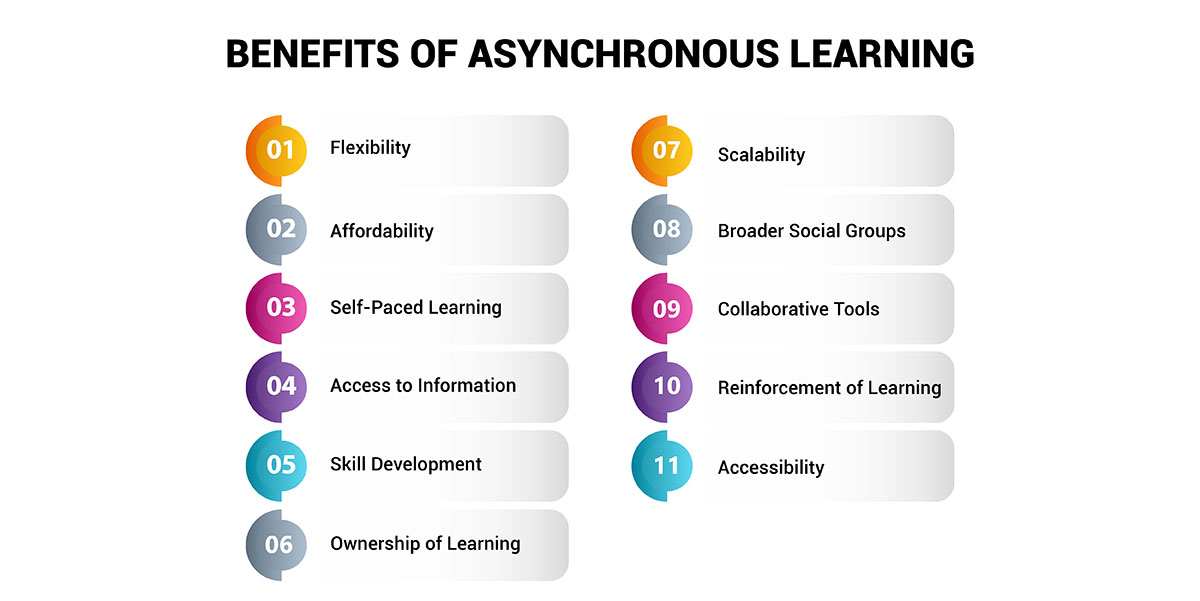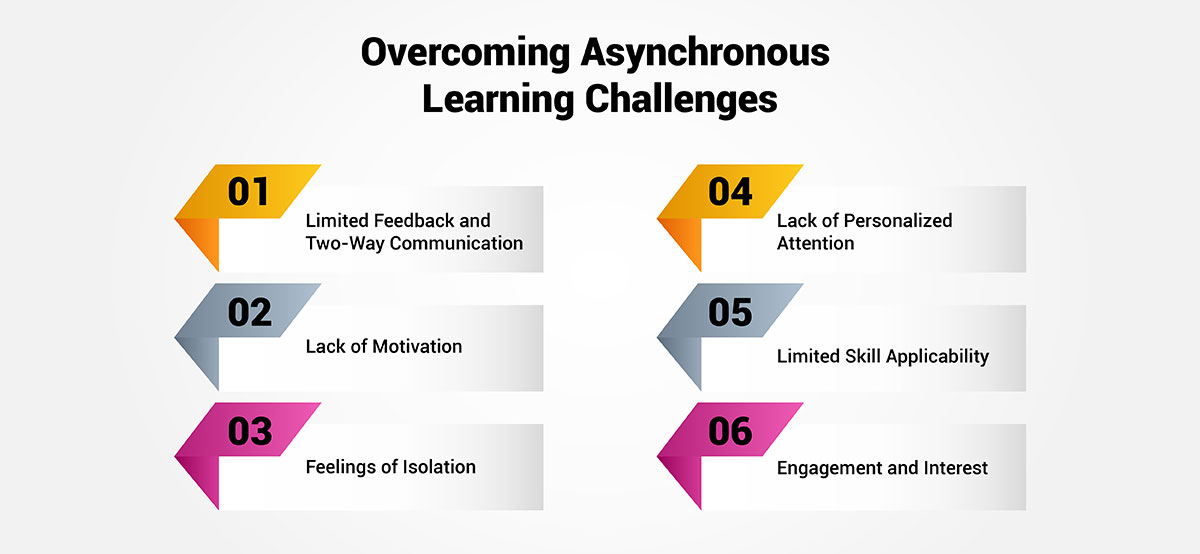Asynchronous Learning: Understanding Its Benefits and Challenges
June 07, 2024Asynchronous learning, often discussed alongside synchronous learning, refers to a flexible education method where students access resources and communicate at their own pace, rather than in real-time. This approach has been significantly boosted by the growth of internet-based technology, enabling learners to engage with online courses and instructional videos on platforms like YouTube without the need for immediate feedback or scheduled attendance.
Asynchronous learning offers unparalleled convenience and autonomy, accommodating diverse learning styles and allowing education to transcend traditional constraints of time and place. This method has become increasingly popular in both online and physical learning settings for its ability to fit into learners' varied schedules and preferences.
Delving into Asynchronous Learning: A Closer Look
Asynchronous learning is a flexible, learner-centered approach that allows students to engage with course materials and complete assignments at their own pace, without the need for real-time interaction with instructors or peers. Unlike synchronous learning, where students and teachers meet at the same time in a physical or virtual classroom, asynchronous learning makes use of digital tools to provide educational content accessible anytime and anywhere.
Using this approach, students can engage with educational content, finish assessments, and connect with instructors and classmates on their own schedule. This flexibility does not mean a lack of discipline; often, there are strict deadlines to ensure timely completion of coursework.
Asynchronous learning can take various forms, including structured e-learning programs, expert-led instructional videos, interactive forums, sequential email lessons, professional development videos, regularly updated educational blogs, and collaborative knowledge-sharing platforms.
The effectiveness of asynchronous learning has been highlighted, especially during the COVID-19 pandemic, which forced a global shift to digital learning. There are numerous asynchronous methods to enhance the online learning experience. For instance, students can watch video lectures repeatedly to understand crucial concepts better and complete assignments at their own pace, receiving feedback asynchronously.
Asynchronous learning accommodates diverse learning styles and schedules, making it suitable for a wide range of learners from K-12 to higher education and professional development. It promotes self-paced progress and allows learners to review digital resources such as readings, assignments, and assessments as often as needed. Communication tools like discussion forums, emails, and messaging systems facilitate interaction without the constraints of real-time communication.
Benefits of Asynchronous Learning
Asynchronous learning offers numerous benefits, making it a versatile and effective educational approach for students of all ages and backgrounds.
Here are some key advantages:

-
1. Flexibility:
Asynchronous learning allows students to access course materials and complete assignments on one’s own timetable, accommodating different schedules and learning preferences. Whether early birds or night owls, students can study at times that suit them best. This flexibility is especially valuable for those with busy schedules, such as working professionals or parents. -
2. Affordability:
By eliminating the need for physical attendance and live instruction, asynchronous learning reduces costs associated with traditional education, such as transportation, accommodation, and classroom maintenance. Online courses often have lower tuition fees, making education more accessible. -
3. Self-Paced Learning:
Students can progress through the material at their own speed, allowing for a deeper understanding of the content. They can pause, review, and revisit materials as needed, which is not always possible in synchronous settings. This approach supports varied learning styles and helps students master difficult concepts without pressure. -
4. Access to Information:
Asynchronous learning provides access to a wide range of resources from anywhere in the world. This includes video lectures, reading materials, assessments, and discussion forums. Students can learn from top educators and institutions without geographical constraints, broadening their educational opportunities. -
5. Skill Development:
Asynchronous learning supports the development of practical and vocational skills. Through various digital tools, students can engage in self-paced training programs, tutorials, and certificate courses that enhance their professional qualifications and career prospects. -
6. Ownership of Learning:
Students in asynchronous courses take responsibility for their learning journey. This autonomy cultivates a sense of ownership and encourages active participation. Learners set their own goals and manage their time effectively, which can lead to increased motivation and engagement. -
7. Scalability:
Asynchronous learning materials can be reused and scaled to accommodate large numbers of students without additional effort from instructors. This scalability is particularly beneficial for organizations and educational institutions aiming to reach a global audience. -
8. Broader Social Groups:
Online asynchronous courses bring together students from diverse backgrounds and locations. This diversity enriches discussions and broadens perspectives, enhancing the overall learning experience. Students can collaborate with peers worldwide, fostering a global understanding and network. -
9. Collaborative Tools:
Despite the self-paced nature of asynchronous learning, students can still engage in meaningful interactions through discussion forums, email, and messaging systems. These tools facilitate communication and collaboration, creating a supportive learning community. -
10. Reinforcement of Learning:
Asynchronous learning allows students to reinforce key concepts by reviewing lectures, participating in discussions, and completing supplementary activities. This repetitive engagement helps solidify knowledge and improve retention. -
11. Accessibility:
Asynchronous learning is particularly advantageous for students with disabilities, as it allows for customizable learning environments that cater to individual needs. Visual or auditory content can be tailored to ensure that all students have equal access to educational resources.
Overcoming Asynchronous Learning Challenges
While asynchronous learning offers numerous advantages, it also comes with its own set of challenges that can affect both students and educators. Understanding these pitfalls is crucial for effectively navigating and mitigating them.

-
1. Limited Feedback and Two-Way Communication:
Asynchronous learning environments often lack the immediacy of feedback and interaction found in traditional classrooms. Students may face delays in receiving responses to their queries or feedback on assignments, which can hinder their understanding and progress.The absence of real-time communication means that learners must rely on discussion forums, emails, and messaging systems, where responses might not be immediate. This delay can lead to frustration and a feeling of disconnect from the learning process. Educators also struggle to gauge student comprehension and engagement without the benefit of immediate feedback, making it challenging to adjust teaching methods in real-time.
-
2. Lack of Motivation:
Maintaining motivation in an asynchronous learning environment can be particularly challenging. Unlike structured, face-to-face classrooms where the presence of an instructor and peers can provide motivation and accountability, asynchronous learners must be self-starters. The absence of a fixed schedule and direct supervision can lead to procrastination and distractions, especially in home environments. Without the immediate engagement of a live instructor, students might find it easier to disengage from their studies, impacting their performance and completion rates. -
3. Feelings of Isolation:
Asynchronous learning can lead to feelings of isolation among students. Working independently without the physical presence of instructors and peers can create a sense of loneliness and detachment from the learning community. The lack of casual social interactions and classroom camaraderie can make learners feel disconnected. This isolation can negatively impact their motivation and engagement, potentially leading to lower levels of satisfaction and success in the course. -
4. Lack of Personalized Attention:
One of the significant disadvantages of asynchronous learning is the limited opportunity for personalized attention. In traditional classrooms, educators can offer immediate, specialized support to students who are struggling or need extra help. However, in an asynchronous setting, this individualized attention is harder to provide. Students might find it challenging to get the specific support they need, leading to frustration and potential academic setbacks. Peer learning, a powerful tool for enhancing understanding through collaborative efforts, is also limited in this format. -
5. Limited Skill Applicability:
Certain skills and subjects may not be effectively taught through asynchronous learning. For instance, practical skills that require hands-on practice, such as surgical training, cannot be fully acquired through online courses alone. While many theoretical and technical skills can be learned asynchronously, disciplines that require physical practice and immediate feedback are less suited to this format. -
6. Engagement and Interest:
Designing engaging and interactive asynchronous courses is more complex than it appears. In live classes, instructors can adjust their teaching methods based on student reactions and provide additional explanations as needed. Asynchronous courses lack this real-time adaptability. Keeping students engaged requires careful planning of the course content and structure to maintain an interest curve that captures and retains their attention. Without this, students may find the material less engaging and struggle to stay focused.
By recognizing and addressing these challenges, educators can better support their students and enhance the overall effectiveness of asynchronous learning environments.
Conclusion
Asynchronous learning presents a revolutionary approach to education, offering unparalleled flexibility, accessibility, and scalability. Through a diverse array of digital tools and resources, learners can engage with course materials at their own pace, transcending the traditional constraints of time and place. This method accommodates diverse learning styles and schedules, empowering students to take ownership of their learning journey and fostering a global learning community.
As technology continues to evolve and shape the landscape of education, asynchronous learning stands as a beacon of innovation, revolutionizing the way we teach and learn. By harnessing the power of digital tools and embracing the principles of flexibility and autonomy, asynchronous learning holds the potential to transform education and empower learners worldwide.




